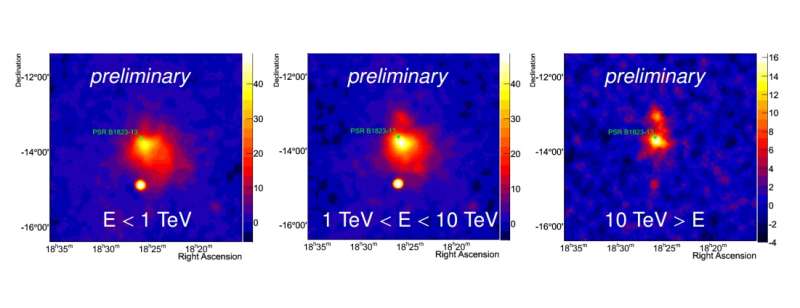November 2, 2016 report
Astrophysicists conduct very high energy studies of a highly extended pulsar wind nebula

(Phys.org)—Astrophysicists from Germany and France have recently performed very high energy studies of the pulsar wind nebula (PWN) designated HESS J1825−137. The findings, presented in a paper published Oct. 27 on arXiv.org, provide new insights on the changing nature of this highly extended nebula.
PWNs are nebulae powered by the wind of a pulsar. Pulsar wind is composed of charged particles and when it collides with the pulsar's surroundings, in particular with the slowly expanding supernova ejecta, it develops a PWN. Therefore, these nebulae could provide interesting information about the interaction of a pulsar with its surroundings. Scientists believe that their properties can be used to infer the geometry, energetics, and composition of the pulsar wind.
HESS J1825−137, discovered in 2005 by the High Energy Stereoscopic System (H.E.S.S.), an array of four imaging atmospheric Cherenkov telescopes located in Namibia, is a highly extended PWN powered by the PSR B1823-13 pulsar. Located some 13,000 light years away, PSR B1823-13 is about 21,000 years old and has a spin period of 101.48 miliseconds.
HESS J1825-137 is known for its strong energy-dependent morphology, as its observed size decreases with increasing energy, which makes it more compact around the position of the pulsar. Last year, a new dataset from the H.E.S.S. galactic plane survey was released, enabling more detailed studies of this peculiar nebula. These data were recently thoroughly analyzed by a team of researchers led by Alison Mitchell of the Max Planck Institute for Nuclear Physics in Germany, to improve our knowledge of HESS J1825-137 and PWNs in general.
"A rich dataset is currently available with H.E.S.S., including H.E.S.S. II data with a low energy threshold, enabling detailed studies of the source properties and environment. We present new views of the changing nature of the PWN with energy, including maps of the region and spectral studies," the scientists wrote in the paper.
They noted that the new dataset is much enhanced compared to the previous one, and offers significantly more sensitive studies. Due to better sensitivity to large areas of weak, low-energy emission, the H.E.S.S. II data allowed the team to detect an additional area of extended emission, revealing that HESS J1825-137 extends further than previously thought.
However, even more crucial to the understanding of the nature of HESS J1825-137, the researchers found that the nebula's size reduces with increasing energy. According to the authors of the paper, this is a clear evidence of the emission being attributable to the pulsar. It also provides some indication of cooling of the electron population over time as the particles are transported away from PSR B1823-13.
"The spectral index of the emission increases with increasing distance from the pulsar, due to the electrons cooling over time, causing the index to become softer. Additionally, the high energy flux decreases with distance from the pulsar, due also to this gradual change in the energy distribution of the electron population, as they cool and are transported through the nebula," the researchers concluded.
All the new findings confirm the strong energy-dependent morphology of HESS J1825-137, proving that the second H.E.S.S. dataset could be helpful in more detailed studies of PWNs that could not have been performed based only on the first data release.
More information: Detailed VHE Studies of the Pulsar Wind Nebula HESS J1825-137, arXiv:1610.08894 [astro-ph.HE] arxiv.org/abs/1610.08894
Abstract
The pulsar wind nebula (PWN) HESS~J1825-137, known to exhibit strong energy dependent morphology, was discovered by HESS in 2005. Powered by the pulsar PSR~B1823-13, the TeV gamma-ray emitting nebula is significantly offset from the pulsar. The asymmetric shape and 21~kyr characteristic age of the pulsar suggest that HESS~J1825-137 is in an evolved state, having possibly already undergone reverse shock interactions from the progenitor supernova. Given its large angular extent, despite its 4~kpc distance, it may have the largest intrinsic size of any TeV PWN so far detected. A rich dataset is currently available with H.E.S.S., including H.E.S.S. II data with a low energy threshold, enabling detailed studies of the source properties and environment. We present new views of the changing nature of the PWN with energy, including maps of the region and spectral studies.
© 2016 Phys.org



















